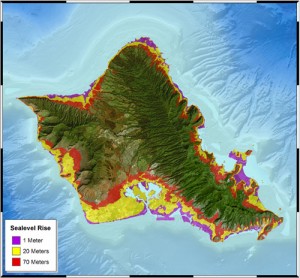|
Earn up to ₹40 per post as scholarship. Unlimited earning potential per month. |
 Researchers have identified the gap, which could be an important missing piece of the puzzle in estimates for past and current sea level changes and for projections of future rises. Global sea levels rose by an average of 1.8mm per year from 1961-2003, according to data from tide gauges. But the main question is how much of this can be pinned to global warming.
Researchers have identified the gap, which could be an important missing piece of the puzzle in estimates for past and current sea level changes and for projections of future rises. Global sea levels rose by an average of 1.8mm per year from 1961-2003, according to data from tide gauges. But the main question is how much of this can be pinned to global warming.
In its landmark 2007 report, the UN’s Nobel-winning Intergovernmental Panel on Climate Change (IPCC) ascribed 1.1 mm per year to thermal expansion of the oceans – water expands when it is heated – and to melt water from glaciers, icecaps and the Greenland and Antarctica icecaps. That left 0.7 mm per year unaccounted for, a mystery that left a number of scientists wondering if the data were correct or if there were some source that had eluded everyone.
A team led by Yadu Pokhrel of the University of Tokyo insist that the answer lies in water that is extracted from underground aquifers, rivers and lakes for human development but is never replenished. The water ultimately makes it to the ocean through rivers and evaporation in the soil, they note.
Groundwater extraction is the main constituent of additions that account for the mystery gap, according to their paper, which is based on computer modelling.
Together, unsustainable groundwater use, artificial reservoir water impounding, climate-driven change in terrestrial water storage and the loss of water from closed basins have contributed a sea-level rise of 0.77 mm per year between 1961 and 2003, about 42% of the observed sea-level rise” it said.
The probe seeks to fill one of the knowledge gaps in the complex science of climate change. Researchers admitted to many unknowns about how the oceans respond to warming, and one of them is sea-level rise, an important question for hundreds of millions of coastal dwellers.
Just a tiny rise, if repeated year on year, can eventually have a dramatic impact in locations that are vulnerable to storm surges or the influx of salt water into aquifers or coastal fields. In its 2007 Fourth Assessment Report, the IPCC said the oceans would rise by between 18 and 59 cm by the century’s end. But this estimate did not factor in melt water from the mighty Greenland and Antarctica ice sheets.
A study published last year by the Oslo-based Arctic Monitoring and Assessment Project (AMAP) said sea-level would rise, on current melting trends, by 90 cm to 1.6 m by 2100. The study has been published in the journal Nature Geoscience.
Picture adopted from : Flooding Oahu